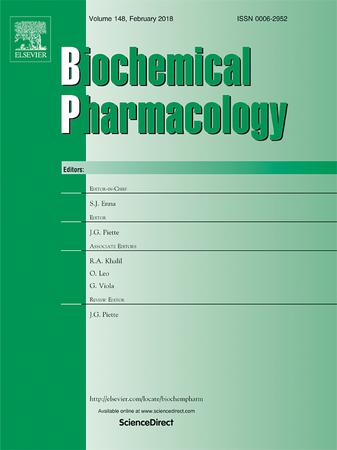OTUB1通过介导ACSL5去泛素化,增强apap诱导的肝损伤中的脂肪酸氧化
IF 5.3
2区 医学
Q1 PHARMACOLOGY & PHARMACY
引用次数: 0
摘要
对乙酰氨基酚(APAP)过量是药物性肝损伤的主要原因。最近的研究表明,脂质代谢失调,特别是脂肪酸氧化(FAO)下降,是apap诱导的急性肝损伤(AILI)的关键因素。OTU结构域含泛素醛结合蛋白1 (OTUB1)是OTU去泛素酶家族的重要成员,参与多种疾病的代谢进程。然而,它是否参与了亚洲农业综合研究所和粮农组织仍不清楚。在此,我们旨在阐明OTUB1在AILI中对FAO调控的作用。我们的研究显示,在AILI中OTUB1表达降低。OTUB1过表达不仅可以减轻肝损伤,还可以改善体内和体外的FAO。相反,在OTUB1敲低的肝细胞中观察到相反的生化变化。在机制上,通过质谱分析,在调节FAO中起关键作用的长链酰基辅酶a合成酶5 (ACSL5)被确定为AILI中OTUB1的新底物。OTUB1与ACSL5相互作用,促进其去泛素化和稳定性。此外,OTUB1对AILI中FAO的保护作用是通过ACSL5的去泛素化来实现的。总的来说,本研究揭示了OTUB1-ACSL5轴在aii进展过程中调控FAO发挥重要作用,并可能成为治疗干预的新靶点。本文章由计算机程序翻译,如有差异,请以英文原文为准。

OTUB1 enhances fatty acid oxidation in APAP-induced liver injury by mediating ACSL5 deubiquitination
Overdosing on acetaminophen (APAP) is the primary cause of drug-induced liver injury. Recent studies have demonstrated that dysregulated lipid metabolism, particularly decreased fatty acid oxidation (FAO), is a key contributor to APAP-induced acute liver injury (AILI). OTU domain-containing ubiquitin aldehyde-binding protein 1 (OTUB1), a crucial member of the OTU deubiquitinase family, has been involved in the metabolic progression of multiple diseases. Nevertheless, its involvement in AILI as well as FAO remains unclear. Here, we aimed to elucidate the effects of OTUB1 on the regulation of FAO in AILI. Our investigation revealed decreased OTUB1 expression in AILI. OTUB1 overexpression not only alleviated liver injury but also improved FAO in vivo and in vitro. Conversely, opposite biochemical changes were observed in hepatocytes with OTUB1 knockdown. Mechanistically, long-chain acyl-CoA synthase 5 (ACSL5), which plays a crucial role in regulating FAO, was identified as a novel substrate of OTUB1 in AILI via mass spectrometry analysis. OTUB1 interacts with ACSL5 and promotes its deubiquitination and stability. Moreover, the protective effect of OTUB1 on FAO in AILI occurred via the deubiquitination of ACSL5. Overall, the present study revealed that the OTUB1-ACSL5 axis plays an essential role in regulating FAO during AILI progression and might be a novel target for therapeutic intervention.
求助全文
通过发布文献求助,成功后即可免费获取论文全文。
去求助
来源期刊

Biochemical pharmacology
医学-药学
CiteScore
10.30
自引率
1.70%
发文量
420
审稿时长
17 days
期刊介绍:
Biochemical Pharmacology publishes original research findings, Commentaries and review articles related to the elucidation of cellular and tissue function(s) at the biochemical and molecular levels, the modification of cellular phenotype(s) by genetic, transcriptional/translational or drug/compound-induced modifications, as well as the pharmacodynamics and pharmacokinetics of xenobiotics and drugs, the latter including both small molecules and biologics.
The journal''s target audience includes scientists engaged in the identification and study of the mechanisms of action of xenobiotics, biologics and drugs and in the drug discovery and development process.
All areas of cellular biology and cellular, tissue/organ and whole animal pharmacology fall within the scope of the journal. Drug classes covered include anti-infectives, anti-inflammatory agents, chemotherapeutics, cardiovascular, endocrinological, immunological, metabolic, neurological and psychiatric drugs, as well as research on drug metabolism and kinetics. While medicinal chemistry is a topic of complimentary interest, manuscripts in this area must contain sufficient biological data to characterize pharmacologically the compounds reported. Submissions describing work focused predominately on chemical synthesis and molecular modeling will not be considered for review.
While particular emphasis is placed on reporting the results of molecular and biochemical studies, research involving the use of tissue and animal models of human pathophysiology and toxicology is of interest to the extent that it helps define drug mechanisms of action, safety and efficacy.
 求助内容:
求助内容: 应助结果提醒方式:
应助结果提醒方式:


